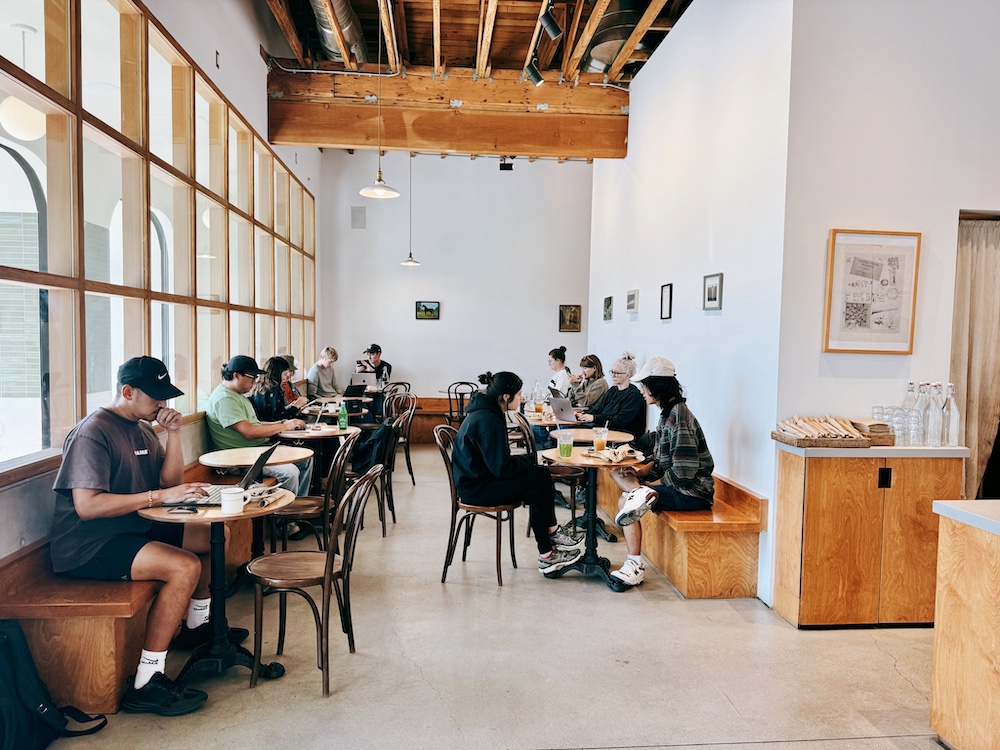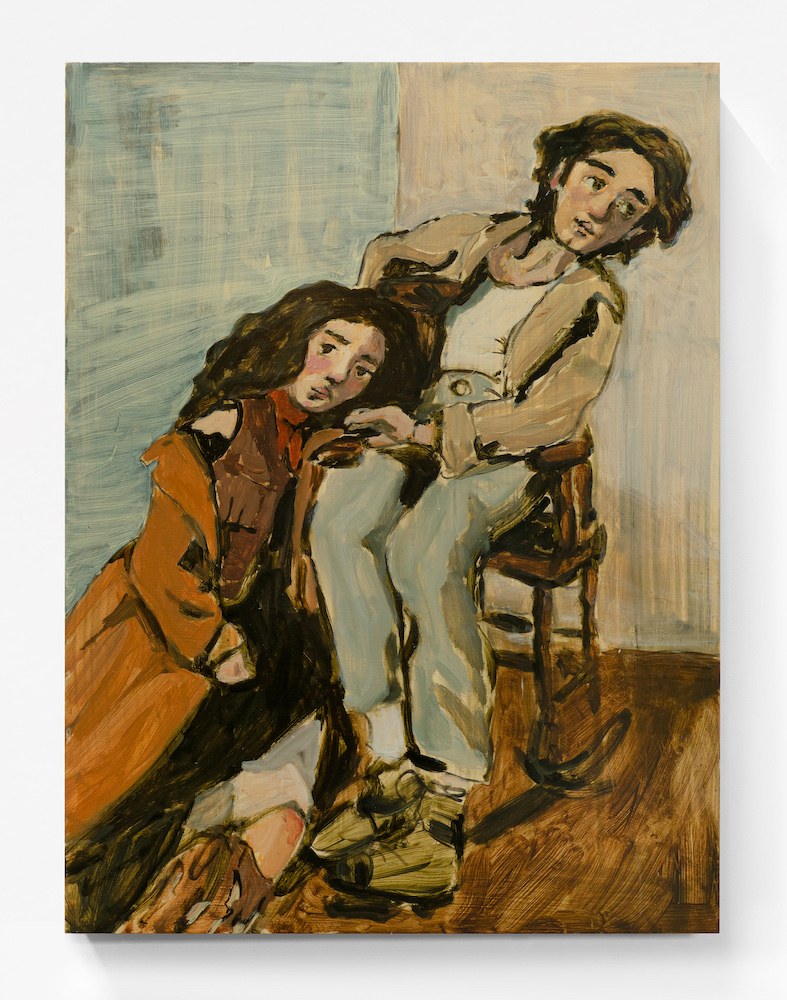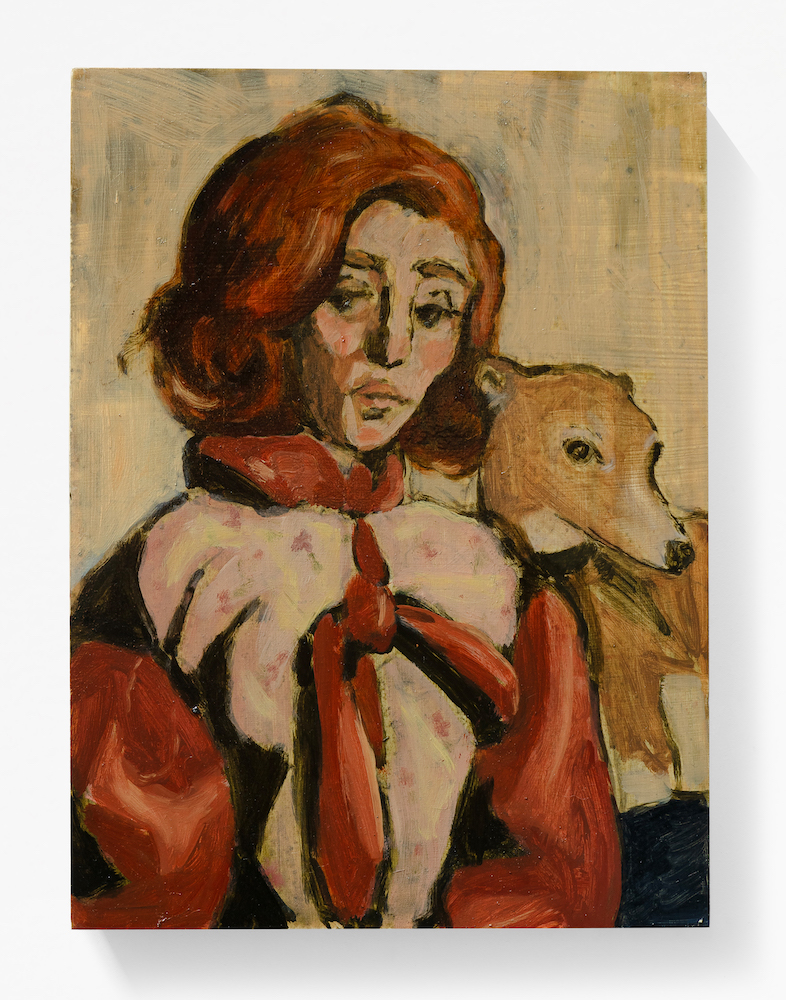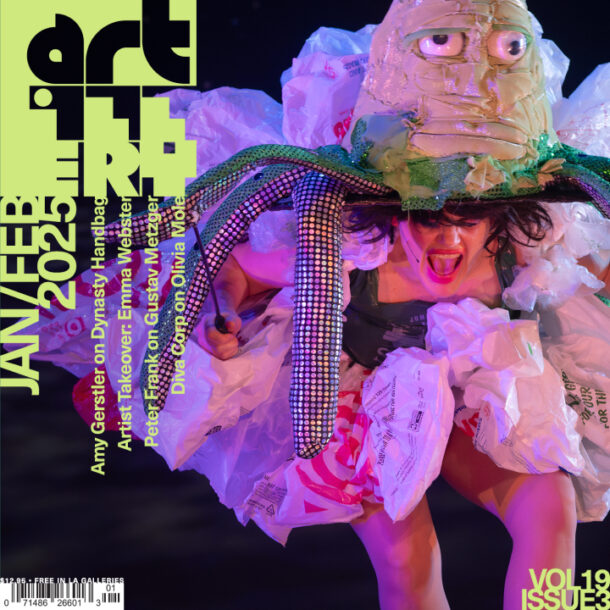Dinner and a Show offers vehicle-bound and spatially-perplexed Angelenos the plan for a complete night out in LA. I go see an exhibition and tell you where to eat within walking distance of the venue, offering a few thoughts on the show
and even more on the restaurant.
THE SHOW: LIORAH TCHIPROUT
The world-building possibilities of dolls, the projections they dutifully absorb, the romantic and clandestine lives we hope they’re living when we tuck Barbie and Ken in the sock drawer together, seem to be at the core of Tchiprout’s paintings. The subjects of these works, according to the press release, are painted from the artist’s own handmade dolls, which she stages in her London studio. Looking at them, I was reminded of a book my parents gave me as a child called Secrets from the Dollhouse, about a defiant young doll named Emma who dreams of going on adventures under the infinite night sky, only to find that she’s happiest at home with her little wooden family. As a young girl, I saw myself in Emma, her dogged independence, the small adventures she steals for herself, and her unremarkable short brown hair. Here, Tchiprout depicts her own dollish projections, weaving them together with themes from Yiddish fiction and poetry (the title of the show comes from a poem by 20th-century poet Anna Margolin), endowing her quasi self-portraits with the mythical quality of a story passed down visually, but never recorded on paper.
The flushed heroine of this exhibition moves through life as a maiden, a clown, a friend, and a lover. Is it inadmissible to say that paintings such as Well loved, but still not sated (2025) and The world lies spellbound at our doorstep (2025) are feminine—unabashedly girly even? And that to me, this quality is good and worthy? Not just the subjects, but the slippery, gossamer surfaces, the creamy brushstrokes, the confectionery pink cheeks, the expressions of woeful longing, and the supple crimson and lavender frocks. I wanted to dislike this work for some high-minded or academic reason, thinking its girlishness simply tickled my baseline love of the conventionally cute, that its automatic appeal was a sign of the easily digestible and fast-forgotten. And yet, these paintings have stuck with me, especially the transparent application of paint on board, which adds so much necessary feeling to the pretty images. I wonder only if the content could be made more strange (the best paintings in the show are more unpolished and less precious) so that the thin, oily surfaces are the cherry on top, rather than the muscle, of this work.
Compare, for example, Dead tired from the burden of a dream (2025) and You’re on the other side of that mirror (2025). The former depicts a young girl, scowling and contorted, staring at the viewer against a pink sky and a yellow moon. This painting feels complete, tied up with a pretty ribbon, but there’s nothing about it that needs to be accounted for. You’re on the other side of that mirror seems to depict the same girl, this time sitting happily with her dog. While the mood is more cheerful, small details, like the dog’s haunch which is nothing more than a few daubs of paint, breaking with its more considered head and upper body, or the wedge of hair sitting over the girl’s shoulder which seems impossibly thick and heavy, create a chasm in the sweetness, like the tart pop of blueberry in the pancakes I was about to eat.
Most of the paintings in the show do indeed have these loose threads to some extent, and the looser they are, the more successful. Looking at Normally, I never miss (2025), I mulled over the rocking chair which is too small for the subject as she slides onto the floor, the hands which could either be of a wooden doll or gloved in stiff brown leather, and the dress which shifts from opaque to transparent, with no suggestion of legs underneath its folds. With maybe one or two exceptions, the curb appeal of these paintings feels balanced by their small contradictions and technical brio.

Cafe Telegrama (photo by Infatuation LA).
THE DINNER (OK, SO IT WAS LUNCH):
Cafe Telegrama is the LA art world’s answer to New York’s Odeon power lunch. Swap the espresso martinis and French onion soup for matcha lattes and breakfast burritos, and the white tablecloths and model waiters for counter service and artist-barista-skaters, and there you have it. X marks the spot here at Melrose Hill’s meeting ground for collectors, dealers, and advisors. Yes, I’m speaking in clichés, but it comes from a place of love and self-identification.
Leaving the Fernberger show, which was all wood-burning stoves and plum pudding, and entering Telegrama, which is all pool parties and soft scrambles, felt like going home. The charming, covered patio, small bistro tables, service continu, exposed wood beams, and mineral green tiles are meant to evoke a European café, but it all feels extremely Californian to me, like Canyon Coffee, All Time, and Erewhon had a baby. It’s the logical conclusion of so-called California cuisine, by which I’m not just referring to the seasonality of the ingredients, the pastured eggs, the artisanal Jyan Isaac bread, or the inevitable avocado toast, but also the energetic frequency that pulses through this place. It’s sunny and bright and hip, and the food is undeniably good, both in quality and taste. Two strains of California cuisine have led to this place. The first is the hippie food, which Woody Allen poked fun at in Annie Hall when he ordered alfalfa sprouts and mashed yeast at the Source Restaurant, and the second is the cuisine credited to chefs like
Alice Waters and Jonathan Waxman, which essentially involves using French technique with local, organic ingredients and inspirations. Tangled together and stretched over decades, we find ourselves at Cafe Telegrama where the alfalfa sprouts come on bagels, the wine is orange, the spiced tea cake is vegan, and the living is easy.

Liorah Tchiprout, The world lies spellbound at our doorstep, 2025. Courtesy the artist and Fernberger.
There is practically no barrier to entry for the gallery set and the gentrifiers here at Telegrama. The menu is short and unsurprising, and I noted a certain confidence here—which is evident in Tchiprout’s practice as well—to present something simple and commodified, knowing it will be done in a way that sets it apart from the rest. While Tchiprout’s paintings contend with clichés of girlish portraiture with strange ruptures and compelling surfaces, Telegrama contends with its own surface-level Instagrammability with a backbone of un-gimmicky and well-executed food. I landed on this conclusion through two dishes—the ricotta pancakes with blueberry compote and the Chinese chicken salad.
Ricotta Pancakes: I’d heard a lot of chatter about these pancakes and seen even more Instagram posts of them (plate askew, long shadow trailing off the iced pistachio latte, you know the vibe). Normally more of a waffle person who loves crunch, I was intrigued by the look of their burnt edges and felt I had to give them a try. These pancakes, two to an order, are very good. Gloriously hot and with a rusty brown exterior that can only be achieved with cast iron and a lot of butter, they probably don’t even need the blueberry compote, just a little syrup. To call a pancake fluffy feels cheap, but for these pancakes, which are so crisp and relatively slim, fluffiness feels like an achievement. I commend Telegrama for not fussing with a classic and just focusing on doing it justice.
Chinese Chicken Salad: Am I the first person to ever have a combination of pancakes and Chinese chicken salad for lunch? Probably not, but I understand if you’re pausing to interrogate my authority as a food writer with an order like this. I just ask that you hear me out. Chinese chicken salad is a loaded dish, both literally and figuratively, but it’s the figurative part that leads me to order it most times I see it on a menu. I grew up eating the stuff—from the deli counter at Gelson’s in the Palisades (RIP), to Chin Chin on Sunset Blvd (RIP), to Chinois on Main in Santa Monica (where it is called Chinois chicken salad). It’s a dish that reached peak popularity in the 80s and 90s, but remains strong at supermarkets and retro holdovers. It’s a very Hollywood dish in the sense that its origins are legendary, if not a little murky. It’s safe to assume that it slowly evolved from some type of Sichuanese cold chicken dish, which would have a similar flavor profile but no lettuce. But then there’s also this rumor-turned-fact that Cary Grant suggested to Sylvia Wu, of 20th-century celeb hangout Madame Wu’s Garden, to add a shredded chicken salad to her menu, leading her to create what we recognize today as Chinese chicken salad.

Liorah Tchiprout, You’re on the other side of that mirror, 2025. Courtesy the artist and Fernberger.
Either way, the dish did not emerge out of a vacuum, and trends like fusion cuisine, the aforementioned California cuisine, diet culture, and exoticism have all contributed to both its creation and its popularity. It’s a perfect, mythical dish—refreshing, crunchy, just to the edge of filling, endearingly passé—and Cafe Telegrama nails it. Their version is pretty much standard: shredded chicken, chopped napa cabbage, toasted slivered almonds, juicy mandarin orange segments, wonton crisps, and a sweet and tangy dressing. When done well like this, proudly uniform and piled high on its plate, it is irresistible. Please do not order it without wonton crisps or with the dressing on the side.
So, is agreeability viable without friction? Only in its peak form, as is the case at Telegrama, where light salads and a short stack of pancakes are a cut above the rest. For art, however, my preference is not for perfection but instead for some balance between rightness and wrongness, digestibility and incomprehension. I found that at Fernberger, in some works more than others, but regardless, the show surpassed itself in unexpected ways. My pleasant afternoon of enjoying nice things turned out to be not just simply pleasant, but actually worthwhile.


